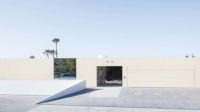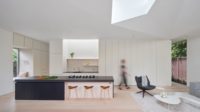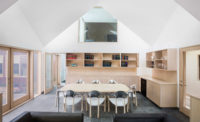Five Los Angeles cultural institutions shed new light on mid-20th-century design efforts.
Pacific Standard Time: Art in L.A. 1945–1980—a collaboration among 60 cultural institutions across Southern California—is a grand bazaar, as eclectic, wide-ranging, and uneven as the period of art it celebrates. Initiated by the Getty Foundation, which provided $10 million in grants, this effort engages venues of radically different scales and aspirations to focus on the evolution of the Los Angeles art scene in the decades after World War II. With nearly every institution in on the act—from major museums to university galleries—art takes on a fluid definition, naturally spilling into architecture and design.
Though Pacific Standard Time (PST) has no single unifying viewpoint, many of the shows suggest that artistic risk taking was free to flourish here, far from New York's and Europe's art establishments, because Los Angeles was not yet taken seriously in the art world. So boundaries were dashed, multiculturalism was celebrated, and experimentation became exuberant, spanning from performance art to sculpture made of light. Gritty street art with subversive undercurrents—focused on societal rifts, identity politics, the Vietnam War—also surfaced, as documented in Under the Big Black Sun: California Art 1974–1981, at the Geffen Contemporary at MoCA.
But if MoCA's Big Black Sun is the noir of PST, the Los Angeles County Museum of Art (LACMA)'s California Design: 1930–1965: “Living in a Modern Way” is its sunny glow. Limelighting Mid-Century modern domesticity, California Design is an instantly engaging show, teeming with stylish, whimsical, or merely exquisitely crafted furniture, toys, fashion, jewelry, ceramics, photography, and surfboards. Nothing is gritty here. This radiant display frames a period in California portrayed as thriving and optimistic, with a booming population: an era between the Great Depression and the Vietnam War, before many ills disrupted the glossy surface.
At the exhibition's entrance, a gleaming 1936 Airstream Clipper trailer greets you, its aerodynamic form evoking a fuselage. The similarities to aircraft (Airstream's designers had trained in aeronautical engineering) introduce a recurring theme: Here, as in Los Angeles's art, new technologies and materials (fiberglass, molded plywood, synthetic resins) from California's booming defense and aeronautical sectors would reappear in inventive peacetime applications. Nearby hangs a prototype of the bent-plywood body litter Charles and Ray Eames designed for the Navy, before harnessing the technology to create chairs. Beside the litter is a ceramic bowl by Gertrud and Otto Natzler, suggesting a related theme: California's tradition of craft, poised to cross over with industrial methods of production.
With a certain fluidity, the show is nominally divided into four sections: Shaping, Making, Living, and Selling California Modern. “Shaping” focuses on early influences, including immigrant waves; “Making” on materials and fabrication; and “Living” on the casual indoor-outdoor lifestyle this mild climate enabled and the postwar housing surge popularized. But as curator Wendy Kaplan points out in the show's catalog, “selling” the carefree California image “permeates” it all, often “blurring boundaries between art and commerce.” A newly prosperous population with a growing middle class, she writes, emerged from the Great Depression and wartime rationing “intoxicated by the power to purchase.”
In that spirit, architects Hodgetts + Fung have given the exhibition a dynamic installation design not unlike a showroom, with a screen that snakes like an unfurling helix through the 25,000-square-foot space. This device provides a continuous backdrop for some 350 objects and their narrative, and creates intimate nooks within the sinuous folds, transcending shortcomings of Renzo Piano's bland and cavernous Resnick Pavilion (2010). Waferlike canopies filter out rays from troublesome skylights, allowing the curators to play diverse objects off one another, regardless of light sensitivity. And the curves cleverly hide large-scale surprises ahead: Raymond Loewy's fiberglass Studebaker (1963–64) or the entire contents of the 1949 Eames House living room, reassembled in a full-sized replica of that space while the original, in Pacific Palisades, is being restored.
Even in an age when a Mid-Century modern aesthetic saturates our common design lexicon, this exhibition offers little-known pieces by famous designers, such as a vanity by R.M. Schindler, and remarkable objects by obscure designers. The latter category includes a Zahara Schatz lamp, its fantastical protocircuit board base of clear heat-slumped acrylic revealing swirls and eddies of current-carrying wire. Playful items abound, from his-and-hers lobster-emblazoned swimwear to the original Barbie (Mattel was a major sponsor of the show). Hints of a darker side appear, but only in their upbeat guises. For example, BOOM!... Or Golden Age!, a nuclear-annihilation-themed board game, a cold war–era artifact, is presented but without mention of the Red Scare's tangible impact on Los Angeles: Hollywood blacklisting.
While California Design is by far PST's biggest show of architecture and design, it has counterpoints and resonances in other exhibitions. The Getty Center's Greetings from L.A.: Artists and Publics 1950–1980 shows images of the Peace Tower (1966), erected in Los Angeles by sculptor Mark di Suvero, with artist Irving Petlin, architect Kenneth Dillon, and others, galvanizing opposition to the Vietnam War. (The tower will be recreated on its original site in West Hollywood in January.) In a grimmer realm, John Divola's photographic Zuma Series, 1977–78, at MoCA, records the decomposition of an abandoned oceanfront building.
Meanwhile, Sympathetic Seeing: Esther McCoy and the Heart of American Modernist Architecture and Design, at the MAK Center, pays homage to the architecture critic whose legacy underlies the LACMA show. A pioneeering advocate for Southern California Modernism, McCoy had an intimate connection to the MAK Center's home—the Schindler House and studio—where she worked as a draftsperson in the 1940s. There, you can now see McCoy on video or read the letters she wrote in fighting to save Irving Gill's nearby Dodge House (demolished in 1970).
A quirkier exhibition is Eames Words, at A+D, curated by Deborah Sussman, who worked with the Eameses in the '50s. The show—like its well-displayed rebus diagram, a letter from Charles Eames to his grandchildren—is essentially a pictogram, pairing quotes from the Eameses with enigmatic clusters of the everyday objects they suggest.
PST is a smorgasbord far heavier on art than architecture, but more architectural fare is coming. A Getty-sponsored collaboration among seven venues, including MoCA and SCI-Arc, will explore Los Angeles architecture from 1940 to the present. Slated to open in 2013, it is likely to serve up a fuller spread—pungent flavors and all.
















Post a comment to this article
Report Abusive Comment